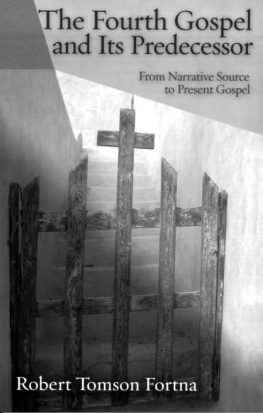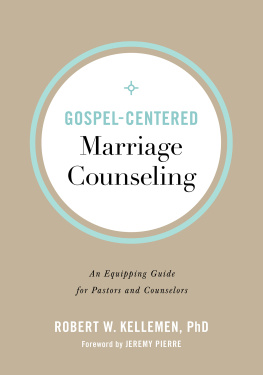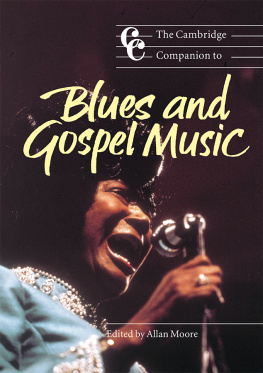Robert Fortna - The Fourth Gospel And Its Predecessor
Here you can read online Robert Fortna - The Fourth Gospel And Its Predecessor full text of the book (entire story) in english for free. Download pdf and epub, get meaning, cover and reviews about this ebook. genre: Religion. Description of the work, (preface) as well as reviews are available. Best literature library LitArk.com created for fans of good reading and offers a wide selection of genres:
Romance novel
Science fiction
Adventure
Detective
Science
History
Home and family
Prose
Art
Politics
Computer
Non-fiction
Religion
Business
Children
Humor
Choose a favorite category and find really read worthwhile books. Enjoy immersion in the world of imagination, feel the emotions of the characters or learn something new for yourself, make an fascinating discovery.
- Book:The Fourth Gospel And Its Predecessor
- Author:
- Genre:
- Rating:3 / 5
- Favourites:Add to favourites
- Your mark:
- 60
- 1
- 2
- 3
- 4
- 5
The Fourth Gospel And Its Predecessor: summary, description and annotation
We offer to read an annotation, description, summary or preface (depends on what the author of the book "The Fourth Gospel And Its Predecessor" wrote himself). If you haven't found the necessary information about the book — write in the comments, we will try to find it.
The Fourth Gospel And Its Predecessor — read online for free the complete book (whole text) full work
Below is the text of the book, divided by pages. System saving the place of the last page read, allows you to conveniently read the book "The Fourth Gospel And Its Predecessor" online for free, without having to search again every time where you left off. Put a bookmark, and you can go to the page where you finished reading at any time.
Font size:
Interval:
Bookmark:

FROM NARRATIVE SOURCE TO PRESENT GOSPEL
ROBERT TOMSON FORTNA
For
Gertrude Tomson Fortna
Jean Fortna
Virginia Page Fortna
PAnr ONE
Parr Two
This book is the sequel to my earlier monograph, The Gospel of Signs, in which I sought to reconstruct the text of the Fourth Gospel's "predecessor." Here I make use of that text, altered slightly in the light of subsequent discussion, so as to apply redaction criticism by comparing it to the text of the present Gospel. The purpose is to return to 4G from the source and to understand both documents in ways that only a redactioncritical approach can afford.
I intended at first to entitle this work "The Evangelist John and His Predecessor," in deliberate allusion to the pioneering redaction-critical work by W. Marxsen: Der Evangelist Markus. But the proposed title would not do, and for two reasons.
In the first place, the new literary criticism of the Bible has taught us to give attention to the text itself and not simply to the author, real or implied, behind the text. We have the book, but the one who produced it, together with that writer's mind and purpose, can only be extrapolated from the text. First of all, then, we had better seek to understand what that text on its own intends. But against the excessive claims of the newer criticism I maintain that to read only the text, without asking also how it came to be and what its original context was, even what its author intended, renders it oddly timeless. So we study both Evangelist and Gospel. Why then avoid speaking of the former in the title?
Because, in the second place, the provisional title was sexist, most obviously in the possessive pronoun "his" but also in using the traditional name "John." The feminist movement in biblical studies has convinced me that these conventions, supposedly innocent in intent and justified by the canon, must be given up. Just as we have no idea of the Evangelist's identity and name, so also of his or her gender. And like all of the Gospels, that according to "John" is in fact anonymous, its apostolic attribution added roughly a century after it was written and on spurious grounds. We cannot know even the degree of likelihood that the writer was a male. So the custom of calling "him" by the traditional name "John" ought to be abandoned.
In the case of this Gospel we have no problem. Except in chapter-and verse citations we can avoid the name John (which in the Gospel itself refers mainly to the Baptist) by speaking of the Fourth Gospel (4G) and the Fourth Evangelist (4E), and often simply of the (present) Gospel and the Evangelist, respectively.
I continue to refer to the Gospel's wording or thought as "Johannine," trusting the adjective to be understood as gender-free. It can then be contrasted with "pre-Johannine," which designates the text, and also the tradition, prior to its present state. For it is precisely the relation between the present Gospel and the document from which it hypothetically developed-namely, between the Fourth Gospel and its predecessor-that engages us.
I have tried to write this book in a way that will include the nonspecialist: by transliterating Greek words, citing the text always in English, and giving explanations of technical terms. Translations from the Greek text of the Fourth Gospel or the source are my own, but often are reminiscent of the Revised Standard Version.
The Introduction is for all readers, whether or not they are approaching redaction criticism of the Fourth Gospel for the first time. The notes are primarily for the scholar. Similarly, the analyses, the third subsection of each numbered section of part 1, are for reference only, tracing the detailed reconstruction of the source's text (see The Plan of the Book, in the Introduction).
Finally, a disclaimer. Some of my students, caught up in my belief in a pre-Johannine Signs Gospel, have imagined that some day an ancient copy of it might be discovered. As no doubt with those who attempt to reconstruct the text of Q (the Synoptic saying source), I have to confess that such a fantasy is not without its appeal. But it quickly turns to dread. If a manuscript of something like the Signs Gospel were to come to light, I should be most uncomfortable to find in how many respects, large and small, my attempt at what may be called creative sleuthing would appear to be inept. One critic (Carson, "Source Criticism," 419) has estimated my confidence in the reconstruction-overconfidence, he would say-to be about nine on a scale of one to ten. My own sense is more nearly a seven. And, like Brown (The Community of the Beloved Disciple, 7), in the end I should be happy if more than half of what I propose is found convincing to others. But what is presented here is a hypothesis whose vindication is not finally based on probabilities or argument about criteria but on its usefulness in coming to terms with this elusive and insistent Gospel.
I am grateful to several institutions for their combined support along the protracted way this book has taken: to Vassar College for research leave and sabbatical; to the American Council of Learned Societies for a fellowship; to the American Philosophical Society for a grant-in-aid; to the Albright Archaeological Institute in Jerusalem for an annual professorship; and to the Ecumenical Institute for Advanced Theological Studies ("Tantur") for accommodation and scholarly collegiality. Without the almost limitless resources of the library at the Ecole Biblique study in Jerusalem would be impoverished indeed. I especially thank the staff and students of St. Bede's Theological College, Umtata, Transkei, for their warm welcome and friendship offered to my family and me at almost the very end of this volume's odyssey.
To the Vassar College Academic Computing Center I am indebted for much special help with the technical problems of producing this work.
I owe a debt of thanks to a number of people who gave assistance and perspective on various parts of the manuscript: Albert J. van Ackere, Betsy Halpern Amaru, Michael H. Barnes, Thomas E. Boomershine, Pieter D. Davidse, Alice G. Howson, Benjamin G. Kohl, Jerome MurphyO'Connor, O.P., Bruce E. Schein, Richard C. Schneider, Robert H. Smith, Giulia Battisti Sorlini.
Several students at Vassar College served as research assistants, and many more as members of my seminars endured exposure even to some of the most rarefied arguments of this study and in turn gave both their reactions and new ideas. I regret that I cannot name them all; these in particular I must thank: Anne Gable, Sarah B. Gordon, John Lo Breglio, Paulette Muller-Girard.
Dr. John A. Hollar and Margret McGinnis of the editorial staff of Fortress Press have greatly added to the book's clarity and usefulness, and Stephanie Egnotovich, the Managing Editor of Fortress Press, guided the manuscript through the process of publication. I thank them all.
Chiefly I am grateful to my friend Walter Wink who tirelessly read virtually every line of this book and some earlier versions of much of it and gave needed encouragement and tough-minded criticism. Another friend and colleague, R. Alan Culpepper, also made many especially helpful suggestions for its final shaping.
Font size:
Interval:
Bookmark:
Similar books «The Fourth Gospel And Its Predecessor»
Look at similar books to The Fourth Gospel And Its Predecessor. We have selected literature similar in name and meaning in the hope of providing readers with more options to find new, interesting, not yet read works.
Discussion, reviews of the book The Fourth Gospel And Its Predecessor and just readers' own opinions. Leave your comments, write what you think about the work, its meaning or the main characters. Specify what exactly you liked and what you didn't like, and why you think so.










